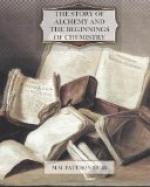The results of analysis by the spectroscope of the light emitted by certain elements at different temperatures may be reasonably interpreted by supposing that these elements are separated into simpler substances by the action on them of very large quantities of thermal energy. The spectrum of the light emitted by glowing iron heated by a Bunsen flame (say, at 1200 deg. C. = about 2200 deg. F.) shows a few lines and flutings; when iron is heated in an electric arc (say, to 3500 deg. C. = about 6300 deg. F.) the spectrum shows some two thousand lines; at the higher temperature produced by the electric spark-discharge, the spectrum shows only a few lines. As a guide to further investigation, we may provisionally infer from these facts that iron is changed at very high temperatures into substances simpler than itself.
Sir Norman Lockyer’s study of the spectra of the light from stars has shown that the light from those stars which are presumably the hottest, judging by the general character of their spectra, reveals the presence of a very small number of chemical elements; and that the number of spectral lines, and, therefore, the number of elements, increases as we pass from the hottest to cooler stars. At each stage of the change from the hottest to cooler stars certain substances disappear and certain other substances take their places. It may be supposed, as a suggestive hypothesis, that the lowering of stellar temperature is accompanied by the formation, from simpler forms of matter, of such elements as iron, calcium, manganese, and other metals.
In the year 1896, the French chemist Becquerel discovered the fact that salts of the metal uranium, the atomic weight of which is 240, and is greater than that of any other element, emit rays which cause electrified bodies to lose their electric charges, and act on photographic plates that are wrapped in sheets of black paper, or in thin sheets of other substances which stop rays of light. The radio-activity of salts of uranium was proved not to be increased or diminished when these salts had been shielded for five years from the action of light by keeping them in leaden boxes. Shortly after Becquerel’s discovery, experiments proved that salts of the rare metal thorium are radio-active. This discovery was followed by Madame Curie’s demonstration of the fact that certain specimens of pitchblende, a mineral which contains compounds of uranium and of many other metals, are extremely radio-active, and by the separation from pitchblende, by Monsieur and Madame Curie, of new substances much more radio-active than compounds of uranium or of thorium. The new substances were proved to be compounds chemically very similar to salts of barium. Their compositions were determined on the supposition that they were salts of an unknown metal closely allied to barium. Because of the great radio-activity of the compounds, the hypothetical metal of them was named Radium. At a later time, radium was isolated by Madame Curie. It is described by her as a white, hard, metal-like solid, which reacts with water at the ordinary temperature, as barium does.




